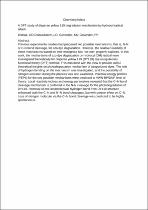 ResearchSpace
ResearchSpace
A DFT study of disperse yellow 119 degradation mechanism by hydroxyl radical attack
JavaScript is disabled for your browser. Some features of this site may not work without it.
- ResearchSpace
- →
- Research Publications/Outputs
- →
- Journal Articles
- →
- View Item
| dc.contributor.author |
Wahab, OO

|
|
| dc.contributor.author |
Olasunkanmi, LO

|
|
| dc.contributor.author |
Govender, Krishna

|
|
| dc.contributor.author |
Govender, PP

|
|
| dc.date.accessioned | 2019-03-11T10:53:35Z | |
| dc.date.available | 2019-03-11T10:53:35Z | |
| dc.date.issued | 2018-12 | |
| dc.identifier.citation | Wahab, O.O., Olasunkanmi, L.O., Govender, K.K., Govender, P.P. 2018. A DFT study of disperse yellow 119 degradation mechanism by hydroxyl radical attack. ChemistrySelect, v 3(46), pp 12988-12997. | en_US |
| dc.identifier.issn | 2365-6549 | |
| dc.identifier.uri | https://onlinelibrary.wiley.com/doi/10.1002/slct.201802904 | |
| dc.identifier.uri | http://hdl.handle.net/10204/10780 | |
| dc.description | Copyright: 2018 Wiley. Due to copyright restrictions, the attached PDF file only contains the abstract of the full text item. For access to the full text item, kindly consult the publisher's website | en_US |
| dc.description.abstract | Previous experimental studies had proposed two possible mechanisms, that is, N-N or C-N bond cleavage, for azo dye degradation. However, the relative feasibility of these mechanisms based on their energetics has not been properly explored. In this work, the mechanisms of azo dye degradation by hydroxyl (OH) radical were investigated theoretically for disperse yellow 119 (DY119) dye using density functional theory (DFT) method. This was done with the view to provide useful theoretical insights on photodegradation mechanism of azopyridone dyes. The role of hydrogen bonding on the mechanism was investigated, and the possibility of nitrogen evolution during the process was also examined. Potential energy profiles (PEPs) for the two possible mechanisms were predicted at VWN-BP/DNP level of theory. Local reactivity indices and energy parameters revealed that the C–N bond cleavage mechanism is preferred to the N-N cleavage for the photodegradation of DY119. Removal of one intramolecular hydrogen bond from DY119 structure enhanced both the C–N and N–N bond cleavages, but with greater effect on C–N. Loss of nitrogen molecule via the C–N bond cleavage was predicted to be highly spontaneous. | en_US |
| dc.language.iso | en | en_US |
| dc.publisher | Wiley | en_US |
| dc.relation.ispartofseries | Worklist;21962 | |
| dc.subject | Azo dye | en_US |
| dc.subject | Density functional theory | en_US |
| dc.subject | DFT | en_US |
| dc.subject | Disperse yellow 119 | en_US |
| dc.subject | Hydroxyl radical | en_US |
| dc.subject | Photodegradation mechanism | en_US |
| dc.title | A DFT study of disperse yellow 119 degradation mechanism by hydroxyl radical attack | en_US |
| dc.type | Article | en_US |
| dc.identifier.apacitation | Wahab, O., Olasunkanmi, L., Govender, K., & Govender, P. (2018). A DFT study of disperse yellow 119 degradation mechanism by hydroxyl radical attack. http://hdl.handle.net/10204/10780 | en_ZA |
| dc.identifier.chicagocitation | Wahab, OO, LO Olasunkanmi, Krishna Govender, and PP Govender "A DFT study of disperse yellow 119 degradation mechanism by hydroxyl radical attack." (2018) http://hdl.handle.net/10204/10780 | en_ZA |
| dc.identifier.vancouvercitation | Wahab O, Olasunkanmi L, Govender K, Govender P. A DFT study of disperse yellow 119 degradation mechanism by hydroxyl radical attack. 2018; http://hdl.handle.net/10204/10780. | en_ZA |
| dc.identifier.ris | TY - Article AU - Wahab, OO AU - Olasunkanmi, LO AU - Govender, Krishna AU - Govender, PP AB - Previous experimental studies had proposed two possible mechanisms, that is, N-N or C-N bond cleavage, for azo dye degradation. However, the relative feasibility of these mechanisms based on their energetics has not been properly explored. In this work, the mechanisms of azo dye degradation by hydroxyl (OH) radical were investigated theoretically for disperse yellow 119 (DY119) dye using density functional theory (DFT) method. This was done with the view to provide useful theoretical insights on photodegradation mechanism of azopyridone dyes. The role of hydrogen bonding on the mechanism was investigated, and the possibility of nitrogen evolution during the process was also examined. Potential energy profiles (PEPs) for the two possible mechanisms were predicted at VWN-BP/DNP level of theory. Local reactivity indices and energy parameters revealed that the C–N bond cleavage mechanism is preferred to the N-N cleavage for the photodegradation of DY119. Removal of one intramolecular hydrogen bond from DY119 structure enhanced both the C–N and N–N bond cleavages, but with greater effect on C–N. Loss of nitrogen molecule via the C–N bond cleavage was predicted to be highly spontaneous. DA - 2018-12 DB - ResearchSpace DP - CSIR KW - Azo dye KW - Density functional theory KW - DFT KW - Disperse yellow 119 KW - Hydroxyl radical KW - Photodegradation mechanism LK - https://researchspace.csir.co.za PY - 2018 SM - 2365-6549 T1 - A DFT study of disperse yellow 119 degradation mechanism by hydroxyl radical attack TI - A DFT study of disperse yellow 119 degradation mechanism by hydroxyl radical attack UR - http://hdl.handle.net/10204/10780 ER - | en_ZA |





